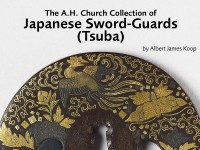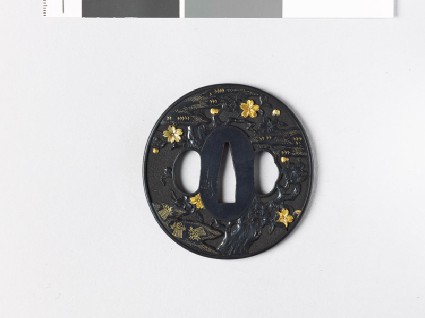The A. H. Church Collection of Japanese Sword-Guards (Tsuba)
An unpublished catalogue of the A. H. Church collection of Japanese sword-guards (tsuba) by Albert James Koop.

Publications online: 1264 objects
Tsuba with cherry tree and clouds
-
Literature notes
In low relief on each face part of a cherry-tree with some gold flowers and buds, also three clouds abutting on the edge; the latter are almost flat and the polished surfaces are enriched with togidashi designs of faggots, flights of birds and patches of powdering; the general ground rough ishime; slender raised border. Signed: Nagaaki [Japanese text] with kakihan [Figure]. (Unrecorded.)
E. Gilbertson Collection? A very similar guard, signed by Kobayashi Yasuke Masakiyo of Matsuye in Idzumo (unrecorded), is in the Victoria and Albert Museum (Hawkshaw Collection, no. 2653). It is, however, considerably larger than the Church example and of coarser finish, both as to the modelling and as to the togidashi, while the shakudō has not the same fine violet sheen. Apart from the signatures the two guards are obviouslu by different hands. Similar work appears on the rim of No.158 and includes the motives here employed, from which it would seem that the faggots are really sections of brushwood fencing. This rim is possibly by yet a third hand.
The work is an imitation of the togidashi process in lacquer-work, where a design is, so to say, first inlaid in the general ground, the whole being then polished (togi) so as to show up (dashi) the design, as though it were submerged in water. Here, apparently the shakudō has been lightly engraved with the design, then heavily gilt all over, and finally rubbed down so as to leave the gilding only in the engraving, with the appearnace of ordinary flush inlay (hirazōgan). -
Details
- Associated place
- Date
- probably early 19th century
- Material and technique
- shakudō, with punched ishime surface, and gold
- Dimensions
- 7.2 x 7 cm (height x width)
- Material index
-
processed material › metal › alloy › copper alloy › shakudō,
- Technique index
- Object type index
-
arms/armour › koshirae › kodogu › tsuba
- No. of items
- 1
- Credit line
- Bequeathed by Sir Arthur H. Church, 1915.
- Accession no.
- EAX.11041
-
Further reading
Koop, Albert James, The A. H. Church Collection of Japanese Sword-Guards (Tsuba), 3 vols (Oxford, Ashmolean Museum, 1929), no. 1041
Glossary (2)
shakudō, tsuba
-
shakudō
alloy of copper and gold, patinated to a dark blue-black colour
-
tsuba
Japanese sword guard.
Location
-
- currently in research collection
Objects are sometimes moved to a different location. Our object location data is usually updated on a monthly basis. Contact the Jameel Study Centre if you are planning to visit the museum to see a particular object on display, or would like to arrange an appointment to see an object in our reserve collections.
Publications online
-

The A. H. Church Collection of Japanese Sword-Guards (Tsuba)
In low relief on each face part of a cherry-tree with some gold flowers and buds, also three clouds abutting on the edge; the latter are almost flat and the polished surfaces are enriched with togidashi designs of faggots, flights of birds and patches of powdering; the general ground rough ishime; slender raised border. Signed: Nagaaki [Japanese text] with kakihan [Figure]. (Unrecorded.)
E. Gilbertson Collection? A very similar guard, signed by Kobayashi Yasuke Masakiyo of Matsuye in Idzumo (unrecorded), is in the Victoria and Albert Museum (Hawkshaw Collection, no. 2653). It is, however, considerably larger than the Church example and of coarser finish, both as to the modelling and as to the togidashi, while the shakudō has not the same fine violet sheen. Apart from the signatures the two guards are obviouslu by different hands. Similar work appears on the rim of No.158 and includes the motives here employed, from which it would seem that the faggots are really sections of brushwood fencing. This rim is possibly by yet a third hand.
The work is an imitation of the togidashi process in lacquer-work, where a design is, so to say, first inlaid in the general ground, the whole being then polished (togi) so as to show up (dashi) the design, as though it were submerged in water. Here, apparently the shakudō has been lightly engraved with the design, then heavily gilt all over, and finally rubbed down so as to leave the gilding only in the engraving, with the appearnace of ordinary flush inlay (hirazōgan).
Notice
Object information may not accurately reflect the actual contents of the original publication, since our online objects contain current information held in our collections database. Click on 'buy this publication' to purchase printed versions of our online publications, where available, or contact the Jameel Study Centre to arrange access to books on our collections that are now out of print.
© 2013 University of Oxford - Ashmolean Museum

